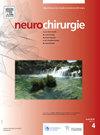颅内脑膜瘤术后系统ICU必要性的评价:以风险为基础的方法。图卢兹大学医院工作经验。
IF 1.4
4区 医学
Q4 CLINICAL NEUROLOGY
引用次数: 0
摘要
背景:颅内脑膜瘤是最常见的良性中枢神经系统肿瘤,通常采用选择性手术切除治疗。虽然结果总体上是有利的,但术后管理仍然存在变数,特别是在常规重症监护病房(ICU)入住方面。鉴于重症监护资源的压力越来越大,确定真正需要icu监护的患者是至关重要的。目的:评价脑膜瘤术后早期并发症,建立实用的风险评分方法,指导ICU住院。方法:我们对203例颅内脑膜瘤切除术(2020-2022)进行了回顾性单中心研究。如果患者已安排手术,且术后至少有一晚ICU监护,则纳入研究。综合终点定义了24小时内icu相关并发症,包括癫痫发作、新的缺陷、延迟觉醒、重新插管、输血、静脉内(IV)抗高血压药物、紧急成像或再手术。分析了22个临床、放射学和外科因素。结果:术后并发症发生率为19.2%,主要为神经系统并发症(13.8%)。三分之二的事件发生在醒来时或麻醉后护理病房(PACU)。单因素分析确定了7个显著的预测因素:颅内高压、肿瘤位置、运动皮质受损伤、手术时间≥3小时、失血量≥500ml、使用渗透疗法和输血。10项风险评分显示高灵敏度(92.3%)和阴性预测值(95.9%),使用1分或更多的分界点。使用该模型,在我们的人群中,36.5%的患者可以安全地避免ICU住院。结论:脑膜瘤术后采用基于风险的方法入院是安全可行的。该评分的实施与扩展PACU监测相结合,可以在不影响患者安全的情况下优化资源利用。前瞻性验证是必要的。本文章由计算机程序翻译,如有差异,请以英文原文为准。
Evaluation of the necessity of systematic ICU after intracranial meningioma surgery: Towards a risk-based approach. Toulouse University Hospital experience
Background
Intracranial meningiomas are the most common benign central nervous system tumors, often managed with elective surgical resection. While outcomes are generally favorable, postoperative management remains variable, particularly regarding routine Intensive-Care Units (ICU) admission. Given increasing pressure on critical care resources, identifying patients who truly require ICU-level monitoring is essential.
Objective
To evaluate early postoperative complications after meningioma surgery and develop a practical risk-based score to guide ICU admission.
Methods
We performed a retrospective single-center study of 203 intracranial meningioma resections (2020–2022). Patients were included if they had scheduled surgery and at least one night of postoperative ICU monitoring. A composite endpoint defined ICU-relevant complications within 24 h, including seizures, new deficits, delayed awakening, reintubation, transfusion, intra-veinous (IV) antihypertensives, and urgent imaging or reoperation. Twenty-two clinical, radiological, and surgical factors were analyzed.
Results
Postoperative complications requiring ICU-level care occurred in 19.2% of cases, mostly neurological (13.8%). Two-thirds of events occurred upon awakening or in the post-anesthesia care unit (PACU). Univariate analysis identified seven significant predictors: intracranial hypertension, falcine location, motor cortex involvement, operative time ≥3 h, blood loss >500 mL, osmotherapy use, and transfusion. A 10-item risk score demonstrated high sensitivity (92.3%) and negative predictive value (95.9%) using a cut-off of 1 or more points. Using this model, in our population, 36.5% of patients could have safely avoided ICU admission.
Conclusion
A risk-based approach to ICU admission after meningioma surgery appears both safe and feasible. Implementation of this score, combined with extended PACU monitoring, could optimize resource use without compromising patient safety. Prospective validation is warranted.
求助全文
通过发布文献求助,成功后即可免费获取论文全文。
去求助
来源期刊

Neurochirurgie
医学-临床神经学
CiteScore
2.70
自引率
6.20%
发文量
100
审稿时长
29 days
期刊介绍:
Neurochirurgie publishes articles on treatment, teaching and research, neurosurgery training and the professional aspects of our discipline, and also the history and progress of neurosurgery. It focuses on pathologies of the head, spine and central and peripheral nervous systems and their vascularization. All aspects of the specialty are dealt with: trauma, tumor, degenerative disease, infection, vascular pathology, and radiosurgery, and pediatrics. Transversal studies are also welcome: neuroanatomy, neurophysiology, neurology, neuropediatrics, psychiatry, neuropsychology, physical medicine and neurologic rehabilitation, neuro-anesthesia, neurologic intensive care, neuroradiology, functional exploration, neuropathology, neuro-ophthalmology, otoneurology, maxillofacial surgery, neuro-endocrinology and spine surgery. Technical and methodological aspects are also taken onboard: diagnostic and therapeutic techniques, methods for assessing results, epidemiology, surgical, interventional and radiological techniques, simulations and pathophysiological hypotheses, and educational tools. The editorial board may refuse submissions that fail to meet the journal''s aims and scope; such studies will not be peer-reviewed, and the editor in chief will promptly inform the corresponding author, so as not to delay submission to a more suitable journal.
With a view to attracting an international audience of both readers and writers, Neurochirurgie especially welcomes articles in English, and gives priority to original studies. Other kinds of article - reviews, case reports, technical notes and meta-analyses - are equally published.
Every year, a special edition is dedicated to the topic selected by the French Society of Neurosurgery for its annual report.
 求助内容:
求助内容: 应助结果提醒方式:
应助结果提醒方式:


